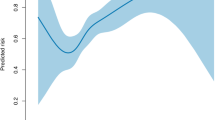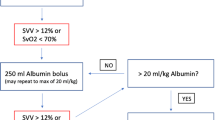Abstract
Background
Optimization of perioperative fluid management is a controversial issue. Weight-adjusted, fixed fluid strategies do not take into account patient hemodynamic status, so that individualized strategies guided by relevant variables may be preferable. We studied this issue in patients undergoing pancreatic surgery within our institution.
Methods
All patients who underwent a laparotomy for pancreatic cancer during a 5-month period at our hospital (AOUI of Verona, Italy) were eligible to be included in this prospective, observational study. According to the responsible anesthesiologist’s free choice, patients received, during surgery, either liberal (12 ml/kg/h) or restricted (4 ml/kg/h) fixed-volume weight-guided replacement fluids or goal-directed (GD) fluid replacement using stroke volume variation (SVV) determined by the FloTrac Vigileo device.
Results
Eighty-six patients were included: 29 in the liberal group, 23 in the restricted group, and 34 in the GD group. The mean duration of surgery was 6 [4–7] h. Patients in the liberal group received more perioperative fluid than those in the GD and restricted groups. Nearly one third of all patients had a major complication, including delayed enteral feeding, and presented a longer duration of hospital stay. Despite the biases related to our limited cohort, there were significantly fewer postoperative complications (such as postoperative fistula, abdominal collection, and hemorrhage) in the restricted and GD groups of patients than in the liberal one.
Conclusion
In patients undergoing pancreatic surgery, a restricted or individually guided GD strategy for management of perioperative fluids can result in fewer complications than a liberal fluid strategy. Larger and randomized investigations are warranted to confirm these data on this domain.
Similar content being viewed by others
References
Pugalenthi A, Protic M, Gonen M, Kingham TP, Angelica MI, Dematteo RP et al. Postoperative complications and overall survival after pancreaticoduodenectomy for pancreatic ductal adenocarcinoma. J Surg Oncol 2016 Feb;113(2):188–93.
Amini N, Spolverato G, Kim Y, Pawlik TM. Trends in hospital volume and failure to rescue for pancreatic surgery. J Gastrointest Surg. 2015 Sept; 19 (9): 1581–92.
Čečka F, Jon B, Čermáková E, Šubrt Z, Ferko A: Impact of postoperative complications on clinical and economic consequences in pancreatic surgery. Ann Surg Treat Res 2016 Jan;90(1):21–8.
De Schryver N, Wittebole X, Hubert C, Gigot JF, Laterre PF, Castanares-Zapatero D. Early hyperlactatemia predicts pancreatic fistula after surgery.BMCAnesthesiol. 2015 Jul 28;15:109.
Brandstrup B, Tønnesen H, Beier-Holgersen R, Hjortsø E, Ørding H, Lindorff-Larsen K et al. Danish Study Group on Perioperative Fluid Therapy. Effects of intravenous fluid restriction on postoperative complications: comparison of two perioperative fluid regimens: a randomized assessor-blinded multicenter trial. Annals of surgery. 2003;238(5):641.
Nisanevich V, Felsenstein I, Almogy G, Weissman C, Einav S, Matot I. Effect of intraoperative fluid management on outcome after intraabdominal surgery. Anesthesiology. 2005;54(1):25–32
Holte K, Foss NB, Andersen J, Valentiner L, Lund C, Bie P et al. Liberal or restrictive fluid administration in fast-track colonic surgery: a randomized, double-blind study. Br J Anaesth. 2007;99(4):500-8.
Bellamy MC. Wet, dry or something else. Br J Anaesth 2006;97(6):755-7.
Lopes MR, Oliveira MA, Pereira VO, Lemos IP, Auler JO Jr, Michard F. Goal-directed fluid management based on pulse pressure variation monitoring during high-risk surgery: a pilot randomized controlled trial. Crit care. 2007;11(5):R100.
Bundgaard-Nielsen M, Holte K, Secher N, Kehlet H. Monitoring of peri-operative fluid administration by individualized goal-directed therapy. Acta anaesthesiol Scand. 2007;51(3):331–40.
Lassen K, Coolsen M M E, Slim K, Carli F, de Aguilar-Nascimento J E, Schäfer M et al. Guidelines for perioperative care for pancreaticoduodenectomy: Enhanced Recovery After Surgery (ERAS(®)) society recommendations. World Journal of Surgery, 2013. 37(2), 240–58.
Benes J, Chytra I, Altmann P, Hluchy M, Kasal E, Svitak R et al. Intraoperative fluid optimization using stroke volume variation in high risk surgical patients: results of prospective randomized study. Crit Care. 2010;14(3):R118.
Claudio Bassi, Giovanni Marchegiani, Christos Dervenis, Micheal Sarr, Mohammad Abu Hilal, Mustapha Adham et al. The 2016 update of the International Study Group (ISGPS) definition and grading of postoperative pancreatic fistula: 11 Years After. Surgery. 2017 Mar;161(3):584–591.
Malleo G, Crippa S, Butturini G, Salvia R, Partelli S, Rossini R et al. Delayed gastric emptying after pylorus-preserving pancreaticoduodenectomy: validation of International Study Group of Pancreatic Surgery classification and analysis of risk factors. HPB (Oxford). 2010;12(9):610–8.
Garner JS, Jarvis WR, Emori TG, Horan TC, Hughes JM. CDC definitions for nosocomial infections, 1988. Am J Infect Control. 1988;16(3):128–40.
Rhodes A, Evans LE, Alhazzani W, Levy MM, Antonelli M, Ferrer R et al. Surviving sepsis campaign: international guidelines for management of sepsis and septic shock: 2016. Intensive Care Med. 2017 Mar;43(3):304–377.
ARDS Definition Task Force, Ranieri VM, Rubenfeld GD, Thompson BT, Ferguson ND, Caldwell E, Fan E et al. Acute respiratory distress syndrome: the Berlin Definition. JAMA. 2012 Jun 20;307(23):2526–33.
Jacob M, Chappell D, Rehm M. Clinical update: perioperative fluid management. Lancet. 2007;369(9578):1984–6.
Chappell D, Jacob M, Hofmann-Kiefer K, Conzen P, Rehm M. A rational approach to perioperative fluid management. Anesthesiology.2008;109(4):723–40.
Prien T, Backhaus N, Pelster F, Pircher W, Büe H, Lawin P. Effect of intraoperative fluid administration and colloid osmotic pressure on the formation of intestinal edema during gastrointestinal surgery. J Clin Anesth.1990;2(5):317–23.
Behman R, Hanna S, Coburn N, Law C, Cyr DP, Truong J et al. Impact of fluid resuscitation on major adverse events following pancreaticoduodenectomy. Am J Surg. 2015;210(5):896–903.
Eng OS, Melstrom LG, Carpizo DR. The relationship of perioperative fluid administration to outcomes in colorectal and pancreatic surgery: a review of the literature. J Surg Oncol. 2015;111(4):472–7.
Holte K, Klarskov B, Christensen DS, Lund C, Nielsen KG, Bie P, et al. Liberal versus restrictive fluid administration to improve recovery after laparoscopic cholecystectomy: a randomized, double-blind study. Ann Surg.2004;240(5):892–9.
Magner JJ, McCaul C, Carton E, Gardiner J, Buggy D. Effect of intraoperative intravenous crystalloid infusion on postoperative nausea and vomiting after gynaecological laparoscopy: comparison of 30 and 10 ml kg(−1). Br J Anaesth.2004;93(3):381–5.
Mayer J, Boldt J, Mengistu AM, Röhm KD, Suttner S. Goal-directed intraoperative therapy based on autocalibrated arterial pressure waveform analysis reduces hospital stay in high-risk surgical patients: a randomized, controlled trial. Crit Care. 2010;14(1):R18.
Forget P, Lois F, De Kock M. Goal-directed fluid management based on the pulse oximeter-derived pleth variability index reduces lactate levels and improves fluid management. Anesth Analgesia. 2010;111(4):910–4.
Challand C, Struthers R, Sneyd JR, Erasmus PD, Mellor N, Hosie KB et al. Randomized controlled trial of intraoperative goal-directed fluid therapy in aerobically fit and unfit patients having major colorectal surgery. Br J Anaesth.2012;108(1):53–62.
Davies SJ, Yates D, Wilson RJT. Dopexamine has no additional benefit in high-risk patients receiving goal-directed fluid therapy undergoing major abdominal surgery. Anesth Analg. 2011;112(1):130–8.
Giglio MT, Marucci M, Testini M, Brienza N. Goal-directed haemodynamic therapy and gastrointestinal complications in major surgery: a meta-analysis of randomized controlled trials. Br J Anaesth.2009;103(5):637–46.
Lees N, Hamilton M, Rhodes A. Clinical review: Goal-directed therapy in high risk surgical patients. Crit Care.2009;13(5):231.
Pearse R, Dawson D, Fawcett J, Rhodes A, Grounds RM, Bennett ED. Early goal-directed therapy after major surgery reduces complications and duration of hospital stay. A randomised, controlled trial. Crit Care.2005;9(6):R687–93.
Reyad AR, Elkharboutly W, Wahba A, Elmorshed M, Hasaneen NA. Effect of intraoperative dobutamine splancnic tissue perfusion and outcome after Wipple surgery. J Crit Care. 2013;28(4):531.e7–15.
Kuper M, Gold SJ, Callow C, Quraishi T, King S, Mulreany A et al. Intraoperative fluid management guided by oesophageal Doppler monitoring. BMJ. 2011 May 24;342:d3016.
Walsh SR, Tang T, Bass S, Gaunt ME. Doppler-guided intra-operative fluid management during major abdominal surgery: systematic review and meta-analysis. Int J Clin Pract. 2008;62(3):466–70.
Abbas SM, Hill AG. Systematic review of the literature for the use of oesophageal Doppler monitor for fluid replacement in major abdominal surgery. Anaesthesia. 2008;63(1):44–51.
Rollins KE, Lobo DN. Intraoperative goal-directed fluid therapy in elective major abdominal surgery: a meta-analysis of randomized controlled trials. Ann Surg. 2016;263(3)465–76.
Som A, Maitra S, Bhattacharjee S, Baidya DK. Goal directed fluid therapy decreases postoperative morbidity but not mortality in major non-cardiac surgery: a meta-analysis and trial sequential analisys of randomized controlled trials. J Anesth. 2017 Feb;31(1):66–81.
Brandstrup B. Fluid therapy for the surgical patient. Best Pract Res Clin Anaesthesiol.2006;20(2):265–83.
Boldt J. Volume therapy in the intensive care patient—we are still confused, but... Intensive Care Med. 2000;26(9):1181–92.
Bruegger D, Jacob M, Rehm M, Loetsch M, Welsch U, Conzen P, et al. Atrial natriuretic peptide induces shedding of endothelial glycocalyx in coronary vascular bed of guinea pig hearts. Am J Physiol Heart Circ Physiol. 2005;289(5):H1993–9.
Senagore AJ, Emery T, Luchtefeld M, Kim D, Dujovny N, Hoedema R. Fluid management for laparoscopic colectomy: a prospective, randomized assessment of goal-directed administration of balanced salt solution or hetastarch coupled with an enhanced recovery program. Dis Colon Rectum.2009;52(12):1935–40.
Futier E, Constantin JM, Paugam-Burtz C, Pascal J, Eurin M, Neuschwander A et al. A trial of intraoperative low-tidal-volume ventilation in abdominal surgery. N Engl J Med. 2013 Aug 1;369(5):428–37.
De Backer D, Heenen S, Piagnerelli M, Koch M, Vincent JL. Pulse pressure variations to predict fluid responsiveness: influence of tidal volume. Intensive Care Med. 2005 Apr;31(4):517–23.
Funding
This study was not supported by any grant.
Author information
Authors and Affiliations
Contributions
LG, AM, NM, VS, and EP conceived and designed the study; NM, AM, KD, GM, and LP collected all sensitive data; AM, LG, and VS performed the statistical analysis; LG, AM, and NM first drafted the manuscript; all authors participated to manuscript preparation and finalization and agreed on its final version.
Corresponding author
Ethics declarations
Conflict of Interest
The authors declare that they have no competing interests.
Ethical Statement
Approval from the Institutional Review Board was obtained (local committee acceptance number 884CESC) along with written informed consent from all patients.
Additional information
Publisher’s Note
Springer Nature remains neutral with regard to jurisdictional claims in published maps and institutional affiliations.
Electronic supplementary material
ESM 1
(PDF 114 kb)
Rights and permissions
About this article
Cite this article
Gottin, L., Martini, A., Menestrina, N. et al. Perioperative Fluid Administration in Pancreatic Surgery: a Comparison of Three Regimens. J Gastrointest Surg 24, 569–577 (2020). https://doi.org/10.1007/s11605-019-04166-4
Received:
Accepted:
Published:
Issue Date:
DOI: https://doi.org/10.1007/s11605-019-04166-4




